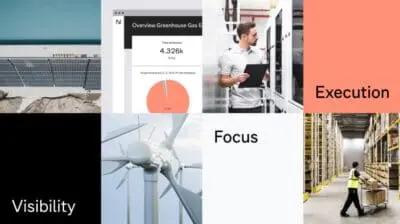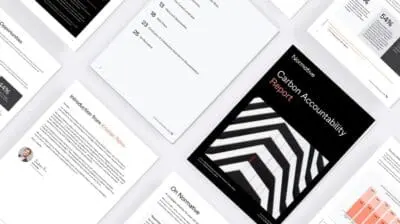How to start engaging your value chain

Six steps for engaging your value chain in carbon measurement and reduction.
As we’ve previously covered, businesses that engage their value chains in carbon measurement and reduction not only do their part to fight climate change – they also stay legally compliant and earn competitive business advantages.
While the reasons to begin value chain engagement are clear, many businesses struggle to get started. This is especially true for large businesses with complex value chains.
Below are six practical steps for engaging your value chain in carbon measurement and reduction, adapted from our free guide for large businesses.
Watch video
1. Find support
Value chain engagement can seem daunting at first, but there are experts and tools that can guide you through the process, including Normative’s carbon accounting engine.
2. Measure
To engage your value chain, you first need to understand its emissions.
Measuring your scope 3 emissions reveals your biggest hotspots, helping you decide where to focus your efforts.
3. Plan
Once you have a clear picture of your scope 3 emissions, the next step is to formulate a value chain engagement plan.
Decide which part of your scope 3 emissions to tackle first. Use your emissions measurement to identify high-impact areas to prioritize, and start from there.
4. Set targets
How much of your scope 3 emissions do you hope to reduce, and by when?
To meet Paris-aligned targets, you should plan to reach net zero by 2050 at the latest, but it’s good to set intermediate targets as well.
5. Formulate a strategy
What steps will you take to achieve your targets?
The precise nature of the strategy will depend on the area of value chain engagement. A few notable examples include:
- Supplier engagement. Reduce your emissions by making suppliers reduce theirs.
- Procurement policy. Make decarbonization a key part of the process for evaluating major purchases and vendor relationships.
- Financial investments. Review the GHG emissions associated with your assets.
- Product design. Integrate net-zero principles into your design.
- Customer engagement. Help customers reduce the carbon footprint of their purchases.
6. Follow up
Measuring your emissions isn’t a one-and-done task.
While the supplier engagement process began with an emissions measurement, it’s also important to continue measuring on an ongoing basis. This helps you follow your reduction efforts and ensure that you’re on track to reach your targets.
Measure your full value chain emissions
Normative’s carbon accounting engine draws from 30 million data points to measure your full scope 3 emissions – giving you the foundation you need to begin reducing your value chain emissions.












